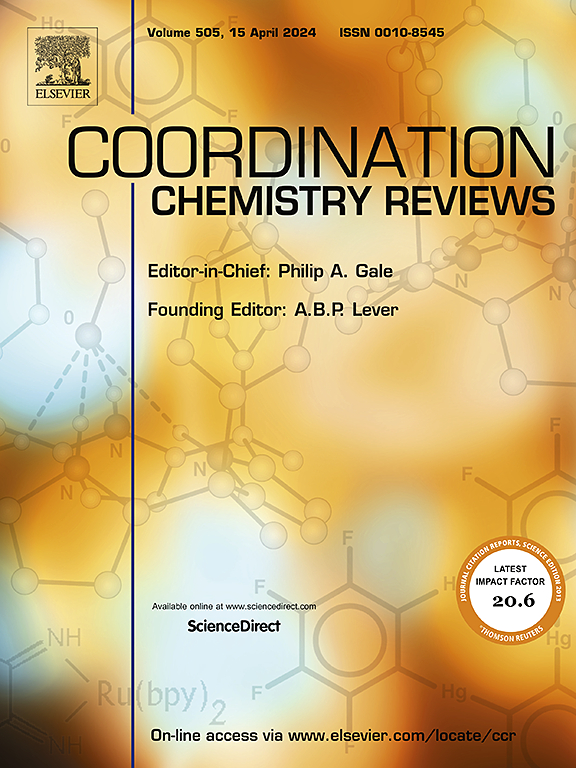二维网状框架纳米片复合材料的设计策略及光学应用综述
IF 20.3
1区 化学
Q1 CHEMISTRY, INORGANIC & NUCLEAR
引用次数: 0
摘要
网状框架纳米片复合材料是由典型的网状框架、金属-有机框架纳米片(MONs)和共价-有机框架纳米片(CONs)与其他有机/无机材料组装而成的一种新型功能材料。该研究以其多样的理化性质和广阔的应用前景,极大地拓展了网状化学和功能材料的研究范围。由于其高度各向异性的结构和固有的可定制化学性质,二维超薄网状框架纳米片的杂交可以克服三维对应物晶体的限制,从而创造新的应用机会。基于网状框架纳米片的复合材料的发展仍处于起步阶段,具有有趣的光学性质。本文综述了这些复合材料的最新进展,包括设计策略和多方面的光学应用。构建复合材料的主要策略可分为两种途径:(1)MONs和CONs作为支架来容纳纳米材料;(II) MONs和CONs与其他1D光纤或2D矩阵集成,以达到期望的性能。此外,还介绍了该复合材料在光敏、发光显示和太阳能转换等方面的代表性应用。最后,对网状框架纳米片复合材料面临的挑战和发展前景进行了展望。本文章由计算机程序翻译,如有差异,请以英文原文为准。

Design strategies and optical applications of two-dimensional reticular framework nanosheet composites: A review
The composites of reticular framework nanosheets represent an emerging category of functional materials, which are assembled by typical reticular frameworks, metal-organic framework nanosheets (MONs) and covalent-organic framework nanosheets (CONs) with other organic/inorganic materials. The research significantly expands the scope of reticular chemistry and functional materials due to versatile physicochemical properties and promising applicability. Owing to their highly anisotropic architectures and inherent tailorable chemistry, the hybridization of 2D ultrathin reticular framework nanosheets could overcome the limitation of the 3D counterpart crystals, thereby creating new application opportunities. The development of composites based on reticular framework nanosheets with intriguing optical properties is still in its infancy. This review summarizes the recent advancements of these composites covering design strategies and multifaceted optical applications. The main strategies to construct the composites could be categorized into two routes: (I) MONs and CONs functioned as scaffolds to accommodate the nanomaterials; (II) MONs and CONs are integrated with other 1D fibers or 2D matrices to achieve the desired performance. Additionally, the representative applications of the composites were presented including the photo-sensing, lighting-emitting display and solar energy conversion. At the end of this review, the challenges and perspectives of the reticular framework nanosheet composites are proposed.
求助全文
通过发布文献求助,成功后即可免费获取论文全文。
去求助
来源期刊

Coordination Chemistry Reviews
化学-无机化学与核化学
CiteScore
34.30
自引率
5.30%
发文量
457
审稿时长
54 days
期刊介绍:
Coordination Chemistry Reviews offers rapid publication of review articles on current and significant topics in coordination chemistry, encompassing organometallic, supramolecular, theoretical, and bioinorganic chemistry. It also covers catalysis, materials chemistry, and metal-organic frameworks from a coordination chemistry perspective. Reviews summarize recent developments or discuss specific techniques, welcoming contributions from both established and emerging researchers.
The journal releases special issues on timely subjects, including those featuring contributions from specific regions or conferences. Occasional full-length book articles are also featured. Additionally, special volumes cover annual reviews of main group chemistry, transition metal group chemistry, and organometallic chemistry. These comprehensive reviews are vital resources for those engaged in coordination chemistry, further establishing Coordination Chemistry Reviews as a hub for insightful surveys in inorganic and physical inorganic chemistry.
 求助内容:
求助内容: 应助结果提醒方式:
应助结果提醒方式:


